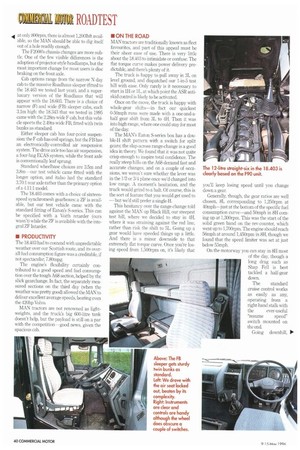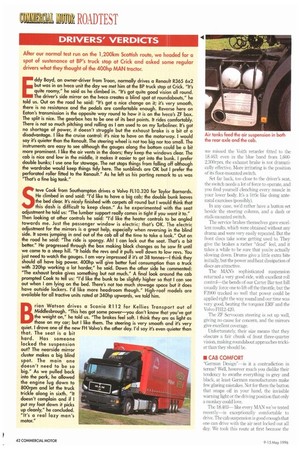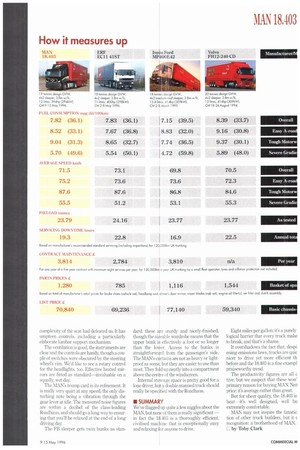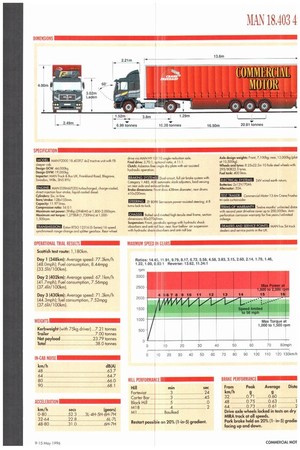MAN OF QUALITY
Page 40

Page 42

Page 44

Page 45

Page 43

If you've noticed an error in this article please click here to report it so we can fix it.
For sheer build quality, MAN is hard to beat so it's strange that the breed doesn't inspire the same fanatical devotion as some other marques. The 18.403 certainly deserves a loyal following...
/nflation is a fact of life, as relevant to the truck market as anywhere else. Not just price inflation, but the inevitable increase in power ratings: the top models in the manufacturers' ranges have gone up from 4501ip to 500hp and have now jumped to the 600 horses of MAN's latest fire-breathing 18.603.
This urge for more power trickles down, and it's become clear that truck builders are pushing ever-higher power ratings for fleet tractors: speed limiters are one factor, and there need be no penalty in fuel economy The fastest and most economical truck in ars Euro-2 group test last year was a 400hp tractor (a Leyland Daf), and the 38-tonne economy record round our Scottish test route is held by a 420hp Volvo.
So 400hp seems to have become a likely choice for both fleets and owner-drivers. After last week's test of an ERF with Cununins Mll power, CM now looks at a MAN aimed at this demanding and highly competitive class.
We've tested the MAN F2000 in 340hp (18.343) and 460hp (18.463) versions, and we've been impressed so far. The 18.403 sits neatly between the two is it as comfortable as they are? • PRODUCT PROFILE MAN's latest three-pronged attack on the market started with the L2000 (replacing the VW-cabbed G90), then the F2000, and has just seen the launch of the M2000 to replace the M90. Of the three ranges, the heavyweight F2000 looks most like its predecessor (the F90) though the changes run deep.
The most obvious change is the range of Euro-2 engines available, covering the broad span from 340hp (replacing the 320hp Euro-1 variant) to the true 591hp of the mighty 18.603 flagship, powered by an 18-litre vee-10.
Though it's clearly based on the F90's unit, the 12-litre straight-six in the 18.403 has higher injection pressures, counterbalancer shafts and mechanical fuel injection controlled by the Bosch EDC (Electronic Diesel Control) system. It shares the cylinder dimensions of the five-in-line. 10-litre unit used in the 18.343, rather than the longer-stroke 12.8-litre six of the 18.463.
The 400hp engine's torque graph is not really a curve at all: the ruler-straight plateau at 1,2751bft (1,730Nm) stretches from 1,000rpm to 1,500rpm, remaining above 1,001/11.ift up ti the red line at annOrpm. Even
at only 800rpm, there is almost 1,2001bft available, so the MAN should be able to dig itself out of a hole readily enough.
The F2000's chassis changes are more subtle. One of the few visible differences is the adoption of projector-style headlamps, but the most important change for most users is disc braking on the front axle.
Cab options range from the narrow N day cab to the massive Roadhaus sleeper (fitted to the 18.463 we tested last year), and a super!Lowry version of the Roadhaus that will appear with the 18.603. There is a choice of narrow (F) and wide (FB) sleeper cabs, each 3.1m high: the 18.343 that vve tested in 1995 came with the 2.28m-wide F cab, but this vehicle sports the 2.49m-wide FB, fitted with twin bunks as standard.
Either sleeper cab has four-point suspension: the F cab has coil springs, but the FB has an electronically-controlled air suspension system. The drive axle too has air suspension, a four-bag ECAS system, while the front axle is conventionally leaf sprung.
Standard wheelbase choices are 3.5m and 3.8mour test vehicle came fitted with the longer option, and italso had the standard 3.70:1 rear axle rather than the primary option of a 4.11:1 model.
The 18.403 comes with a choice of sixteenspeed synchromesh gearboxes: a ZF is available, but our test vehicle came with the standard fitting of Eaton's S-series. This can be specified with a Voith retarder (ours wasn't) while the ZF is available with the integral ZF Intuder.
• PRODUCTIVITY The 18A03 had to contend with unpredictable weather over our Scottish route, and its overall fuel consumption figure was a creditable, if not spectacular, 7.80mpg.
The engine's flexibility certainly contributed to a good speed and fuel consumption over the tough A68 section, helped by the slick gearchange. In fact, the separately measured sections on the third day (when the weather was pretty good) allowed the MAN to deliver excellent average speeds, beating even the 420hp Volvo.
MAN tractors are not renowned as lightweights, and the truck's big 600-litre tank doesn't help, but the payload is still on a par with the competition—good news, given the spacious cab.
• ON THE ROAD
MAN tractors are traditionally known as fleet favourites, and part of this appeal must be their sheer ease of use. There is very little about the 18.403 to intimidate or confuse. The flat torque curve makes power delivery predictable, and there's plenty of it.
The truck is happy to pull away in 31, on level ground, and dispatched our 1-in-5 test hill with ease. Only rarely is it necessary to start in 111 or 11., at which point the ASR antiskid control is likely to be activated.
Once on the move, the truck is happy with whole-gear shifts—in fact our quickest 0-50mph runs were made with a one-and-ahalf gear shift from 3L to 4H. Then it was into high range, where one could stay for most of the day.
The MAN's Eaton S-series box has a double-II shift pattern with a switch for split gears; the slap-across range-change is a good idea in theory. We found that it was not quite crisp enough to inspire total confidence. The really steep hills on the A68 demand fast and accurate changes, and on a couple of occasions, we weren't sure whether the lever was in the 1/2 or 3/4 plane once we'd changed into low range. A moment's hesitation, and the truck would grind to a halt. Of course, this is the sort of feature that you would get used to — but we'd still prefer a single-H.
This hesitancy over the range-change told against the MAN up Black Hill, our steepest test hill, where we decided to stay in 4H. where it was straining against the red line, rather than risk the shift to 5L. Going up a gear would have speeded things up a little. And there is a minor downside to that extremely flat torque curve. Once you're losing speed from 1,500rpm on, it's likely that you'll keep losing speed until you change down a gear.
Generally, though, the gear ratios are well chosen, 8L corresponding to 1 .25Orpm at 40mph—just at the bottom of the specific fuel consumption curve—and 50mph in 8H coming up at 1,300rpm. This was the start of the solid green band on the rev-counter, which went up to 1,70Orpm. The engine should reach 56mph at around 1,450rpm in 8H, though we found that the speed limiter was set at just below 55mph.
On the motorway you can stay in 8H most of the day, though a long drag such as Shan Fell is best tackled a half-gear down.
The standard cruise control works as easily as any, operating from a right-hand stalk with the ever-useful "resume speed" switch mounted on the end.
Going downhill, IP'
we missed the Voith retarder fitted to the 18.463: even in the blue band from 1,6002,30Orpm. the exhaust brake is not dramatically effective, More irritating is the position of its floor-mounted switch.
Set far back, too close to the driver's seat, the switch needs a lot of force to operate, and von find yourself clenching every muscle in :r lower body It's a little like doing antenatal exercises (possibly).
In any case. we'd rather have a button set beside the steering column, and a dash or stalk-mounted switch.
The service brakes themselves gave excellent results, which were obtained without any drama and were very easily repeated. But the front discs take some getting used to. They give the brakes a rather "dead" feel, and it takes a while to be sure that you're actually slowing down. Drums give a little extra bite initially but the power and heat dissipation of discs are attractive.
The MAN's sophisticated suspension returned a very good ride, with excellent roll control—the bends of our Carter Bar test hill usually force one to lift off the throttle, but the F2000 tracked so well that power could be applied right the way round and our time was very good, beating the torquier ERF and the Volvo F1112-420.
The ZF Servocom steering is set up well, giving no cause for concern, and the mirrors give excellent coverage.
Unfortunately, their size means that they obscure a fair chunk of front three-quarter vision, making roundabout approaches trickier than they should be.
• CAB COMFORT
"German Design"—is it a contradiction in terms? Well, however much you dislike their tendency to swathe everything in grey and black, at least German manufacturers make few glaring mistakes. Not for them the button that snaps off in your hand, the invisible warning light or the driving position that only a monkey could love.
The 18.403— like every MAN we've tested recently—is exceptionally comfortable to drive. The cab suspension is good enough that one can drive with the air seat locked out all day. We took this route at first because the
complexity of the seat had defeated us. It has umpteen controls, including a particularly elaborate linnbar support mechanism.
The ventilation is good, the instruments are clear and the controls are handy, though a couple of switches were obscured by the steering wheel's rim. We'd like to see a rotary control for the headlights, too. Effective heated mirrors are fitted as standard-invaluable on a squally, wet day.
The MAN's trump card is its refinement. It is really very quiet at any speed, the only disturbing note being a vibration through the gear lever at idle. The measured noise figures are within a decibel of the class-leading Roadhaus, and should go a long way to ensuring that you'll be relaxed at the end of a long driving day.
The FB sleeper gets twin hunks as stan
dard: these are sturdy and nicely-finished, though the sizeable wardrobe means that the upper bunk is effectively a foot or so longer than the lower. Access to the bunks is straightforward from the passenger's side. The MAN's curtains are not as heavy or lightproof as some, but they are easier to use than most. They fold up neatly into a compartment above the centre of the windscreen.
Internal stowage space is pretty good for a lone driver, but a double-manned truck should really he specified with the Roadhaus.
I SUMMARY
We've flagged up quite a few niggles about the MAN, but none of them is really significant in fact the 18.403 is a thoroughly efficient, civilised machine that is exceptionally easy and relaxing for anyone to drive. Eight miles per gallon: its a purely logical harrier that every truck make to break and that's a shame.
It overshadows the fact that, despi ening emissions laws, trucks are quit nicer to drive yet more efficient th before and the 18.403 is a fine exampl praiseworthy trend.
The productivity figures are all c tive, but we suspect that these won' primary reason for buying MAN. Neil price: it's average rather than great.
But for sheer quality. the 18.403 is heat-it's well designed, well be extremely comfortable.
MAN may not inspire the fanatic: tion of other truck builders, but it c. recognition: a brotherhood of MAN,: L: by Toby Clark Price as tested: £75,075 (ex-VAT). Includes: full air kit, £1,410; passenger air seat, £365; alloy wheels, £1,130; 60061 fuel tank, £425; 80dB(A) "Silent" package, £905.
Engine: 11.97 litres, 394hp (294kW).
GCW: 38 tonnes. Payload: 23.79 tonnes. Speed: 71.5km/h (44.4mph). Fuel consumption: 7.82mpg (36.11it/ 100km).
SPECIFIC:U*10N
MEM MAN E2000 113.403FLT 4x2 tredve unit with 93 Sleeper cab Design GCW: 44,000kg Design GVW. 19,000Icg. Importer: MAN Truck & Bus UK, Frank/and Road, Blagrave, Swindon, Wilts, 5N5 8YU. drive via MAN 9( 13110 single-reduction axle. Final drive: 3.70:1; optional ratio, 4.11:1. Clutch: Asbestos 'Free single dry plate with air-assisted hydraulic operation. Axle design weights: Front, 7,100kg; rear, 13,000kg (alai at I 0,500kg). Wheels and tyres:8 25x22.5in 10-bole steel wheels with 295/801:222 5 lyres.
Enin MAN 028661..19201 turbocharged. charge-cooled, direct injection Four-stroke, liquid-cooled diesel.
Cylinders; Six, tn-line.
Sam/stroke: 128x155mm.
Capacity:11.97 litres.
Compression ratio: 16.0.1 Maximum net power 39411rp (294kW) at 1.800-2,000rpir Maximum net torque: 1,2751b8r1,730Nm) at 1,000
1 ,50Orprn.
EMIZENSMI Eaton RISC) 12316 IS Series) 16 speed synchromesh range-change and splItter gearbox. Rear-wheel
BRAKING SYSTEMS: Dual-circuit, full air brake system with Category I ABS ASP aulornofic slack adjusters, load sensing or rear axle and exhaust brake Brake dimensions: Front discs 438rnm diameter, rear drums al 07(220MM
OMR ZE 8098 Servocam power-assisted steering; 49 turns locktodock.
MUM Bolted and ricetted high tensile steel frame, section dimensions 80x270xEmm Suspension: front, parabolIc springs with hydraulic shock absorbers and anti-roil bar rear, four-bellow air suspension with hydraulic shock obse rbers and anti-roll bar.
DRIVERS' VERDICTS
After our normal test run on the 1,200km Scottish route, we headed for a spot of sustenance at BP's truck stop at Crick and asked some regular drivers what they thought of the 400hp MAN tractor.
y Boyd, an owner-driver from Troon, normally drives a Renault R365 6x2 but was in an Iveco unit e day we met him at the BP truck stop at Crick. "It's quite roomy," he said as he climbed in. "It's got quite good vision all round. The driver's side mirror on the lveco creates a blind spot at roundabouts," he told us. Out on the road he said: "It's got a nice change on it; it's very smooth, there is no resistance and the pedals are comfortable enough. Reverse here on Eaton's transmission is the opposite way round to how it is on the Iveco's ZF box. The split is nice. The gearbox has to be one of its best points. It rides comfortably. There is not so much pitching and rolling as I am used to on my Turboliner. It's got no shortage of power, it doesn't struggle but the exhaust brake is a bit of a disadvantage. I like the cruise control: it's nice to have on the motorway. I would say it's quieter than the Renault. The steering wheel is not too big nor too small. The instruments are easy to see although the gauges along the bottom could be a bit more prominent. I like the air vents in the doors; they keep the windows clear. The cab is nice and low in the middle, it makes it easier to get into the bunk. I prefer double bunks; I use one for stowage. The net stops things from falling off although the wardrobe would keep things tidy here. The sunblinds are OK but I prefer the perforated roller fitted to the Renault." As he left us his parting remark to us was "That's a fine big tank."
Steve Cook from Southampton drives a Volvo F110.320 for Taylor Barnards. He climbed in and said: "I'd like to have a big cab; the double bunk leaves the bed clear. It's nicely finished with carpets all round but I would think that this dash is difficult to keep clean." As he experimented with the seat adjustment he told us: "The lumbar support really comes in tight if you want it to." Then looking at other controls he said: "I'd like the heater controls to be angled towards me. Just the passenger window is electric; that's OK. The electric adjustment for the mirrors is a great help, especially when reversing in the blind side. It saves jumping in and out of the cab all of the time to take a look." Out on the road he said: "The ride is spongy. Ah! I can lock out the seat. That's a bit better." He progressed through the box making block changes as he saw fit until we came to a steep hill. "It holds the revs and it pulls well down to low revs. You just need to watch the gauges. I am very impressed if it's at 38 tonnes—I think they should all have big power. 400hp will give better fuel consumption than a truck with 320hp working a lot harder," he said. Down the other side he commented: "The exhaust brake gives something but not much." A final look around the cab prompted Cook to tell us: "I'd like the bunk to be slightly higher so that I can see out when I am lying on the bed. There's not too much stowage space but it does have outside lockers. I'd like more headroom though." High-roof models are available for all tractive units rated at 340hp upwards, we told him.
B'' , rian Watson drives a Scania RI 12 for Kellies Transport out of Middlesbrough. "This has got some power—you don't know that you've got
the weight on," he told us. "The brakes feel soft. I think they are as light as those on my car; but I like them. The steering is very smooth and it's very quiet. I drove one of the new FH Volvo's the other day. I'd say it's even quieter than that. The seat is a bit hard. Has someone locked the suspension out? The nearside mirror cluster makes a big blind spot. The main one doesn't need to be so big." As we pulled back into the park, he allowed the engine lug down to 800rpm and let the truck trickle along in sixth. "It doesn't complain and if I put my foot down it picks up cleanly," he concluded. "It's a real lazy man's motor."
















































































































